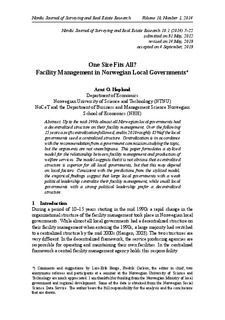| dc.contributor.author | Hopland, Arnt Ove | |
| dc.date.accessioned | 2014-10-10T12:43:36Z | |
| dc.date.accessioned | 2015-02-10T11:50:06Z | |
| dc.date.available | 2014-10-10T12:43:36Z | |
| dc.date.available | 2015-02-10T11:50:06Z | |
| dc.date.issued | 2014 | |
| dc.identifier.citation | Nordic Journal of Surveying and Real Estate Research 2014, 10(1):7-22 | nb_NO |
| dc.identifier.issn | 1459-5877 | |
| dc.identifier.uri | http://hdl.handle.net/11250/275728 | |
| dc.description | Open Journal Systems | nb_NO |
| dc.description.abstract | Up to the mid-1990s almost all Norwegian local governments had
a decentralized structure on their facility management. Over the following
15 years a swift centralization followed, and in 2010 roughly 85% of the local
governments used a centralized structure. Centralization is in accordance
with the recommendation from a government commission studying the topic,
but the arguments are not unambiguous. This paper formulates a stylized
model for the relationship between facility management and production of
welfare services. The model suggests that it is not obvious that a centralized
structure is superior for all local governments, but that this may depend
on local factors. Consistent with the predictions from the stylized model,
the empirical findings suggest that large local governments with a weak
political leadership centralize their facility management, while small local
governments with a strong political leadership prefer a decentralized
structure. | nb_NO |
| dc.language.iso | eng | nb_NO |
| dc.publisher | The Finnish Society of Surveying Sciences | nb_NO |
| dc.title | One size fits all? Facility management in Norwegian local governments | nb_NO |
| dc.type | Journal article | nb_NO |
| dc.type | Peer reviewed | nb_NO |
| dc.date.updated | 2014-10-10T12:43:36Z | |
| dc.source.pagenumber | 7-22 | nb_NO |
| dc.source.volume | 10 | nb_NO |
| dc.source.journal | Nordic Journal of Surveying and Real Estate Research | nb_NO |
| dc.source.issue | 1 | nb_NO |
| dc.identifier.cristin | 1151356 | |
